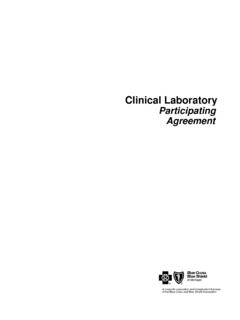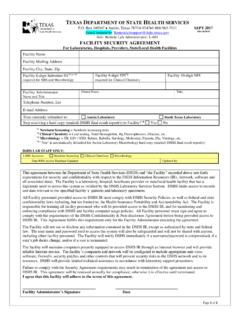Transcription of APPENDIX E CONTRACTING LABORATORY SERVICES
1 APPENDIX E CONTRACTING LABORATORY SERVICES Introduction This APPENDIX provides general guidance on federal CONTRACTING and CONTRACTING terminology as used for negotiated procurements. Federal agencies, and laboratories doing business with them, must follow applicable provisions of the Federal Acquisition Regulations (FAR) and agency-specific supplements. The examples provided in this APPENDIX are based primarily on procedures followed by the Geological Survey (USGS). This APPENDIX addresses selecting a LABORATORY to establish SERVICES that supplement an agency s in-house activities through the CONTRACTING of additional outside support. This APPENDIX offers a number of principles that may be used when selecting a service provider, establishing a contractual agreement , and later working with a contract LABORATORY . These principles may also be applied to contractors that are located outside of the United States.
2 In such cases, legal counsel will need to review and advise an agency concerning pertinent issues related to international contracts. This APPENDIX also covers LABORATORY audits that are part of a final selection process and other activities that take place until the contract is concluded. Chapter 5 (Obtaining LABORATORY SERVICES ) supports this APPENDIX with a general description on how to obtain LABORATORY SERVICES . Chapter 7 (Evaluating Methods and Laboratories) complements this APPENDIX by considering information related to LABORATORY evaluations that are conducted throughout the term of a project whether or not this work is specifically covered by a contract. Obtaining support for LABORATORY analyses is already a practice that is familiar to a number of federal and state agencies. The following discussion will apply: C Agency: A federal or state government office or department, (or potentially any other public or private institution) that offers a solicitation or other mechanism to obtain outside SERVICES ; C Proposer: A person, firm, or commercial facility that submits a proposal related to providing SERVICES ; and C Contractor: A person or firm that is awarded the contract and is engaged in providing analytical SERVICES .
3 Contents Introduction .. E-1 Request for Proposals The Solicitation .. E-7 Proposal Requirements .. E-10 Proposal Evaluation and Scoring Procedures E-21 The Award .. E-31 For the Duration of the Contract .. E-31 Contract Completion .. E-36 References .. E-36 JULY 2004 E-1 MARLAP CONTRACTING LABORATORY SERVICES Furthermore, the size and complexity of some agency projects will clearly exceed the extent of the information presented here. In its present form, this APPENDIX serves to touch on many of the issues and considerations that are common to all projects, be they large or small. MARLAP draws attention to another dimension of the overall CONTRACTING process by considering how the data quality objectives (DQOs) and measurement quality objectives (MQOs) are incorporated into every stage of a project as described earlier in greater detail (Chapters 2, Project Planning Process, and 3, Key Analytical Planning Issues and Developing Analytical Protocol Specifications).
4 In this regard, an agency s project managers and staff are given an opportunity to consider options with some foresight and to examine the larger picture, which concerns planning short- or long-term projects that utilize a contractor s SERVICES . As SERVICES are acquired, and later as work is performed, the specific concepts and goals outlined by the DQOs and MQOs will be revisited. This becomes an iterative process that offers the possibility to further define objectives as work is conducted. Whenever the DQOs or MQOs are changed, the contract should be modified to reflect the new specifications. Employing the MQOs and tracking the contractor s progress provides a means by which project managers and contract- LABORATORY technical staff can return and review the project at any point during the contract period. This allows for repeated evaluations to further optimize a project s goals and, if anticipated in the contract s language, perhaps even provides for the option to revise or redirect the way performance-based work is conducted.
5 The Office of Federal Procurement Policy (OFPP, 1997) has developed a Performance-Based Service CONTRACTING review checklist to be used as a guide in developing a performance-based solicitation. The checklist contains minimum required elements that should be present for a contract to be considered performance-based. Performance-Based Service CONTRACTING focuses on three elements: a performance work statement; a quality assurance project plan (QAPP); and appropriate incentives, if applicable. The performance work statement defines the requirements in terms of the objective and measurable outputs. The performance work statement should answer five basic questions: what, when, where, how many, and how well. The work statement should structure and clearly define the requirements, performance standards, acceptable quality levels, methods of surveillance, incentives if applicable and evaluation criteria. A market survey should be conducted so that the marketplace and other stakeholders are provided the opportunity to comment on draft performance requirements and standards, the proposed QA project plan, and performance incentives, if applicable.
6 A number of benefits arise from establishing a formal working relationship between an agency and a contractor. For example: A contract is a legal document that clearly defines activities and expectations for the benefit of both parties engaged in the contractual relationship. MARLAP E-2 JULY 2004 CONTRACTING LABORATORY SERVICES The process of drafting language to cover legal considerations may well include contributions from legal staff. Legal guidance may be obtained as needed at any time during the planning stages or later when a contract is in place. However, the core of a contractor s proposal, and eventually the contract itself, provide the foundation of technical work that is required to complete a project or attain an ongoing program goal. In this regard, aside from legal issues that are an integral part of every contract, this APPENDIX s principal focus is on the LABORATORY process or technical work-related content of the contract.
7 The statement of work (SOW) first appears as part of the agency s request for proposal (RFP) and later is essentially incorporated into the proposal by the proposer when responding to the RFP. When work is underway, the SOW becomes a working document that both the agency and contractor refer to during the life of the contract. Legal challenges concerning project results ( , LABORATORY data) may arise during the contract period. The language in a contract should offer sufficient detail to provide the means to circumvent potential or anticipated problems. For example, attention to deliveries of samples to the LABORATORY on weekends and holidays or data reporting requirements that are designed to support the proper presentation of data in a legal proceeding are important aspects of many federal- and state-funded contracts. Overall, this APPENDIX incorporates a sequence that includes both a planning and a selection process.
8 Figure E-1 illustrates a series of general steps from planning before a contract is even in place to the ultimate termination of the contract. An agency first determines a need as part of planning, and along the way advertises this need to solicit proposals from outside service providers who operate analytical LABORATORY facilities. Planning future work, advertising for, and later selecting SERVICES from proposals submitted to an agency takes time perhaps six or more months pass before a LABORATORY is selected, a contract is in place, and analytical work begins. The total working duration of a contract, for example, might cover SERVICES for a brief time (weeks or months) and in other cases, many contracts may run for a preset one-year period or for a more extended period of three to five years with optional renewal periods during that time. The MARLAP user will find that planning employs a thought process much like that used to prepare an RFP.
9 In general, one starts with questions that define a project s needs. Further, by developing Analytical Protocol Specifications (APSs) which include specific MQOs, one enters an iterative process such that at various times data quality is checked in relation to work performed both in-house and by the outside service provider. Overall, planning results in the development of a project plan document ( , QAPP). During planning, a project manager and the agency staff can consider both routine and special analytical SERVICES that may be required to provide data of definable quality. The SOW serves to integrate all technical and quality aspects of the project, and to define how specific quality-assurance and quality-control activities are implemented during the time course of a contract. Also, at an early stage in planning, the agency may choose to assemble a team to serve as the Technical Evaluation Committee (TEC; Section JULY 2004 E-3 MARLAP CONTRACTING LABORATORY SERVICES ).
10 The main role of the TEC is in selecting the contract LABORATORY by reviewing proposals and by auditing LABORATORY facilities. The TEC is discussed later in this APPENDIX , however, the key issue here concerns the benefit to establishing this committee early on, even to the point of including TEC members in the initial planning activities. The result is a better informed evaluation committee and a team of individuals that can help make adjustments when the directed planning process warrants an iterative evaluation of the way work is performed under the contract. Overall, planning initiates the process that characterizes the nature of the CONTRACTING process to follow. Procurement of SERVICES Recognizing that the procurement process differs from agency to agency, the following guidance provides a general overview to highlight considerations that may already be part of or be incor-porated into the current practice.



















